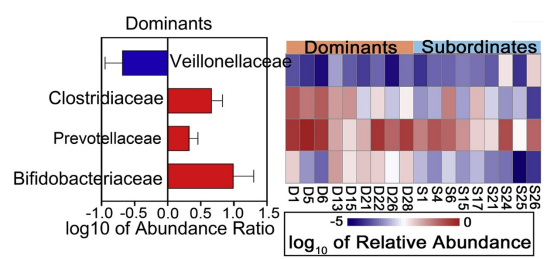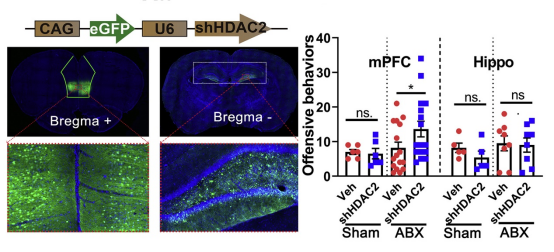On Mar 8, 2022, Prof. Hui-Li Wang's lab at Hefei University of Technology published a paper in Cell Reports titled Gut Microbiota Shapes Social Dominance Through Modulating HDAC2 in the Medial Prefrontal Cortex. Social hierarchy is a fundamental socially organized behavior that is prevalent in humans and herd animals and is closely related to the physical and mental health of the organism. This study reports that socially dominant rats can be distinguished from subordinates based on their intestinal microbiota. When dysbiosis is induced, rats are predisposed to a subordinate state, while dysbiotic rats reclaim social dominance following microbiota transplantation. First, the gut microbiota of rats with different social dominance were analyzed. The intestinal flora of the dominant rats was enriched with clostridiaceae, prevotella and bifidobacteriaceae, but the number of these flora was small in thesubordinate rats (shown inFigure 1). This suggests that gut microbiota has relevance to social dominance status.

Figure 1. Relative abundance of bacterial communities associated with social dominance status.
To further investigate the importance of gut microbiota on dominance, the study analyzes the bacterial community reshaped by antibiotics and donor fecal microbiota transplant, they discovered that butyrate-producing bacteria may have an impact on social dominance. Rats with subordinate status caused by intestinal flora disorders were able to reverse their subordinate status and become dominant after receiving either an intraperitoneal injection of sodium butyrate or an intestinal transplantation with Clostridium butyrate. This suggests that Clostridium butyrate in the intestinal flora is the main flora regulating social rank.
Finally, this study has shown that sodium butyrate acts as an inhibitor of histone deacetylase 2 (HDAC2) to exert a protective effect across the blood-brain barrier into the brain. HDAC2 levels were increased in the medial prefrontal cortex (mPFC) region of rats after receiving antibiotic treatment, and decreased after intraperitoneal injection of sodium butyrate or intestinal transplantation with Clostridium butyricum. Specific knockdown of neuronal HDAC2 levels in the mPFC region of colony-disordered rats by viral tools promotes dominance (shown inFigure 2). In summary, this study reveals the epigenetic mechanism by which the gut-brain axis shapes social hierarchical status: antibiotic-induced gut flora disruption is followed by elevated levels of HDAC2 in the mPFC region of the brain, reduced excitatory postsynaptic currents, and ultimately a shift in hierarchical status.

Figure 2. After knocking down HDAC2, the rats gained a dominant status.
Master Tian Wang, Master Jinchun Xu and Prof. Yi Xu contributed equally to the paper. Prof. Yi Xu and Prof. Hui-Li Wang are the corresponding authors of the paper. The research project was supported by the National Key Basic Research Program of China, the National Science Foundation of China, the Fundamental Research Funds for the Central Universities, and the Key Research and Development Project in Anhui.
Link: https://doi.org/10.1016/j.celrep.2022.110478
